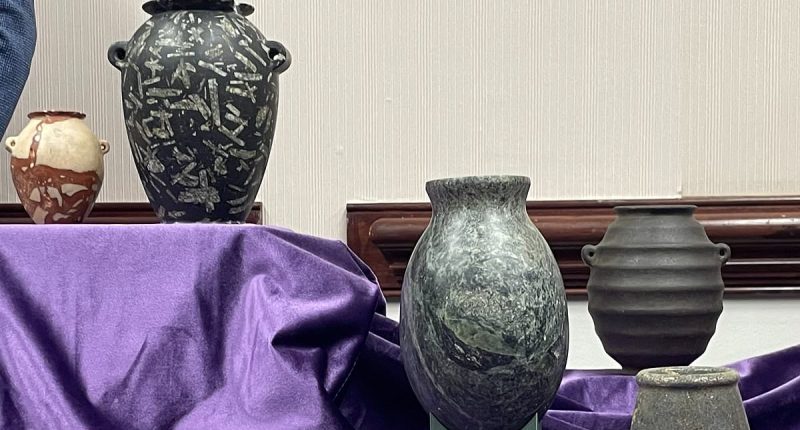Share this @internewscast.com
A Florida retailer and podcaster has unveiled a private collection of ancient Egyptian vases he believes could rewrite history.
Matt Beall, the CEO of the major retail company Bealls Stores, has dedicated the past three years to acquiring 85 hard-stone vessels crafted from a variety of stones, such as granite, limestone, and quartz.
Many date back more than 5,000 years, but they feature a level of precision, symmetry, and detail that he says rivals modern machine work.
These vases, each carved from single blocks of hard stone, boast intricately shaped handles, precisely hollowed interiors, and bases with accuracy down to a thousandth of an inch.
‘The claim that stone and copper chisels were employed is absolutely preposterous,’ Beall stated at the Cosmic Summit, a conference focused on alternative history in North Carolina.
‘There was certainly a lathe involved. But the tools needed to make these things aren’t in the archaeological record.’
Beall, who also hosts the Matt Beall Limitless podcast, has spent countless hours scouring auction sites and antiquities dealers, acquiring pieces he believes hold the key to a lost technology. He has also teamed up with engineers and researchers to probe the mystery behind the vases’ construction.
However, Beall’s claims challenge traditional views of Egyptian craftsmanship and have sparked debate among scholars. While experts admire the ancient stonework, they say there’s no proof of lathes or advanced lost tools.

Matt Beall, CEO of Bealls Stores, has spent the last three years acquiring 85 hard-stone vessels carved from granite, limestone and quartz. He showcased his collection at the Cosmic Summit, a conference on alternative history held in North Carolina

The vases, carved from single blocks of hard stones like granite, limestone and quartz crystal, feature intricately shaped handles, finely hollowed interiors and bases accurate to thousandths of an inch
Over 40,000 similar vases have been recovered from sites like the Step Pyramid of Djoser, and many are dated to before 2800 BC. Despite their age, many exhibit surprising symmetry and fine detailing.
They are among the oldest artifacts of ancient Egypt, with some dating back over 6,000 years to the Predynastic period, which spanned from 4000 to 3000BC.
The earliest examples were found in graves, where they were likely used in religious or funerary rituals.
By the time of Egypt’s First Dynasty, around 3100BC, stone vases had become widespread and increasingly sophisticated, used to hold oils, perfumes or offerings, and were often buried with the dead.
Beall’s controversial theory builds on observations made as far back as 1883, when famed British archaeologist Flinders Petrie discovered a trove of goods, noting signs that some vases may have been turned on lathes.
‘The curves of vases are so regular, and the polish so fine, that it seems as if some mechanical means, such as a rotating appliance, must have been employed,’ Petrie wrote in his studies.
While some archaeologists argue that such precision can be explained by highly skilled manual craftsmanship, refined over generations, Beall has put his money and time on Petrie’s side.

Stone vases are among the oldest artifacts of ancient Egypt, with some dating back over 6,000 years to the Predynastic period from 4000 to 3000BC

‘Interior tool marks are present on most, if not all, of these artifacts, which is pretty fascinating,’ Beall said
‘We know they were made before the third dynasty, so they could go way back to before the Younger Dryas,’ said Beall.
The Younger Dryas is a controversial period proposed to have ended around 11,600 BC.
While not widely accepted by mainstream scholars, some fringe researchers have linked it to a cataclysmic event that may have wiped out a forgotten advanced civilization, possibly the makers of these vases.
Beall has been working with the Artifact Research Foundation, a team of meteorologists and engineers who specialize in ancient technologies.
Together, they have used structured-light scanning, a method that projects light patterns to create highly accurate 3D models, on around 30 of the vases.
CT scans have been performed on 35, offering a deeper look at their internal structure and uniformity.

Beall has spent countless hours scouring auction sites and antiquities dealers online, acquiring pieces he believes hold the key to a lost technology
Beall pointed to CT scans of a thin granite vase, which revealed that both the top and sides are nearly perfectly round, with variations of less than one-thousandth of an inch, a level of accuracy rarely seen in ancient artifacts.
A separate study of 22 vases by Dr Max Fomitchev-Zamilov, a computer scientist from the Moscow Institute of Electronic Technology, uncovered shape errors as small as 15 microns, making them up to 10 times more precise than vases carved using modern machinery.
Dr Fomitchev-Zamilov also noted that many of the vases appeared to be perfectly centered, suggesting a highly controlled method for aligning and rotating the stone during carving, which is typically associated with machine tools like lathes.
However, the findings have not yet been peer-reviewed, and the researchers acknowledge the need for independent academic verification.
Some of the vases have openings that are smaller than a human finger, baffling experts on how ancient people made a small, precise hole and then removed all the material inside thousands of years ago.

A separate study of 22 vases by Dr Max Fomitchev-Zamilov, a computer scientist from the Moscow Institute of Electronic Technology, uncovered shape errors as small as 15 microns, making them up to 10 times more precise than vases carved using modern machinery

Some of the vases have openings that are smaller than a human finger, baffling experts on how ancient people made a small, precise hole and then removed all the material inside thousands of years ago
‘Interior tool marks are present on most, if not all, of these artifacts, which is pretty fascinating,’ Beall said.
‘It’s strong evidence of lathe use. You just don’t get those fine, precise lines inside these objects unless they’re being cut with a very sharp tool.
‘Now, whether that tool was diamond-tipped or something else, we don’t know. But these are some of the hardest stones on Earth.
‘And to think those lines, these aren’t spiral grooves, by the way, they’re horizontal lines, cleanly cutting across the stone. So yes, we do see tool marks inside the material, but so far, no physical tool remnants have been found within the cuts.’
















